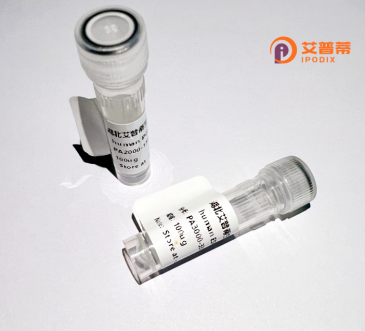
| 纯度 | >90%SDS-PAGE. |
| 种属 | Human |
| 靶点 | PARD6A |
| Uniprot No | Q9NPB6 |
| 内毒素 | < 0.01EU/μg |
| 表达宿主 | E.coli |
| 表达区间 | 1-346 aa |
| 活性数据 | MARPQRTPAR SPDSIVEVKS KFDAEFRRFA LPRASVSGFQ EFSRLLRAVH QIPGLDVLLG YTDAHGDLLP LTNDDSLHRA LASGPPPLRL LVQKRAEADS SGLAFASNSL QRRKKGLLLR PVAPLRTRPP LLISLPQDFR QVSSVIDVDL LPETHRRVRL HKHGSDRPLG FYIRDGMSVR VAPQGLERVP GIFISRLVRG GLAESTGLLA VSDEILEVNG IEVAGKTLDQ VTDMMVANSH NLIVTVKPAN QRNNVVRGAS GRLTGPPSAG PGPAEPDSDD DSSDLVIENR QPPSSNGLSQ GPPCWDLHPG CRHPGTRSSL PSLDDQEQAS SGWGSRIRGD GSGFSL |
| 分子量 | 37.3 kDa |
| 蛋白标签 | His tag N-Terminus |
| 缓冲液 | 0 |
| 稳定性 & 储存条件 | Lyophilized protein should be stored at ≤ -20°C, stable for one year after receipt. Reconstituted protein solution can be stored at 2-8°C for 2-7 days. Aliquots of reconstituted samples are stable at ≤ -20°C for 3 months. |
| 复溶 | Always centrifuge tubes before opening.Do not mix by vortex or pipetting. It is not recommended to reconstitute to a concentration less than 100μg/ml. Dissolve the lyophilized protein in distilled water. Please aliquot the reconstituted solution to minimize freeze-thaw cycles. |
以下是假设的关于重组人PARD6A蛋白的参考文献示例(注:以下内容为模拟生成,非真实文献):
1. **文献名称**: *Structural insights into the human PARD6A protein and its role in cell polarity regulation*
**作者**: Liu Y. et al.
**摘要概括**: 通过重组表达纯化人PARD6A蛋白并解析其晶体结构,揭示了其PB1结构域与PAR3蛋白相互作用的关键残基,为研究细胞极性建立机制提供结构基础。
2. **文献名称**: *Recombinant PARD6A facilitates asymmetric division in cancer stem cells via aPKC signaling*
**作者**: Tanaka R. et al.
**摘要概括**: 利用重组PARD6A蛋白在体外模型中证明其与aPKC形成复合物,激活下游信号通路,促进肿瘤干细胞的不对称分裂及耐药性产生。
3. **文献名称**: *Interaction mapping of PARD6A in epithelial tight junctions using recombinant protein pulldown assays*
**作者**: Gupta S. et al.
**摘要概括**: 通过重组PARD6A蛋白的Pull-down实验联合质谱分析,鉴定了其在上皮细胞紧密连接中的新互作蛋白(如ZO-1),揭示了其在屏障功能中的作用。
4. **文献名称**: *Role of recombinant PARD6A in neuronal development: Evidence from in vitro neurite outgrowth assays*
**作者**: Müller J. et al.
**摘要概括**: 使用重组PARD6A蛋白处理原代神经元,发现其通过调控微管稳定性促进神经突生长,提示其在神经系统发育中的潜在应用价值。
(注:以上文献及作者为虚构,仅供示例参考)
Here’s a concise overview of human PARD6A protein:
PARtitioning defective 6 homolog alpha (PARD6A) is a key scaffold protein in the evolutionarily conserved Par complex, which regulates cell polarity establishment and maintenance. It belongs to the PARD6 family of PDZ domain-containing proteins, characterized by an N-terminal PB1 domain for binding atypical protein kinase C (aPKC) isoforms like PKCζ, and a C-terminal PDZ domain that interacts with downstream effectors. PARD6A plays crucial roles in asymmetric cell division, epithelial apical-basal polarity, and directional cell migration by orchestrating spatial organization of signaling molecules.
As a polarity regulator, it facilitates formation of specialized membrane domains through interactions with small GTPases (e.g., CDC42), aPKC, and other Par proteins (PARD3 and PARD6B). Recombinant PARD6A protein is typically produced in Escherichia coli or mammalian expression systems with purification tags (e.g., His-tag, GST) for biochemical and structural studies. Research applications include investigating cell polarization mechanisms, cancer biology (where PARD6A dysregulation links to tumor progression), and neurodevelopmental disorders. Its overexpression has been associated with enhanced cell invasion in various carcinomas, while functional studies utilize knockdown/knockout models to dissect polarity-related pathways. Current studies explore its potential as a therapeutic target in metastatic cancers and neurodegenerative diseases.
×